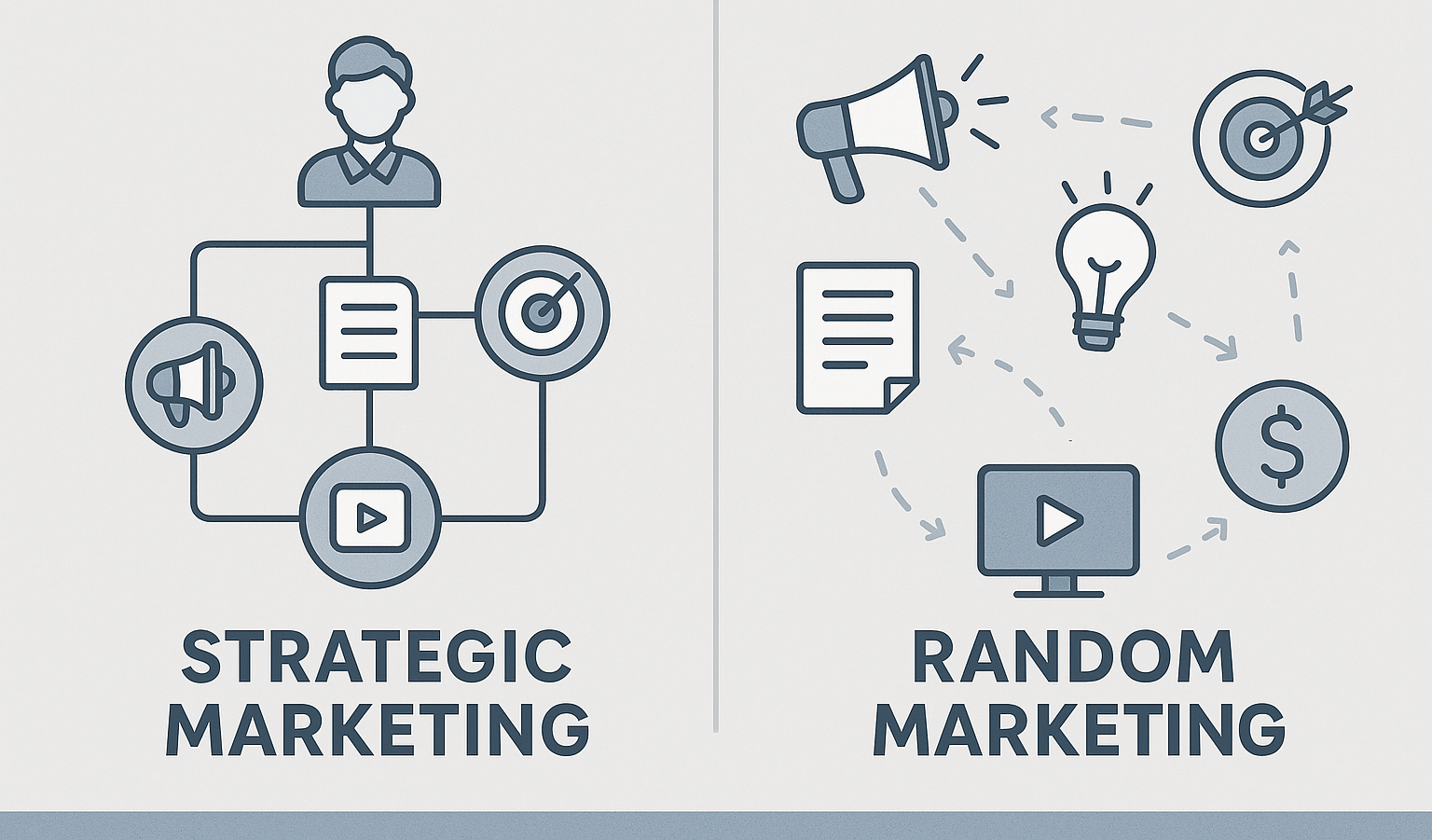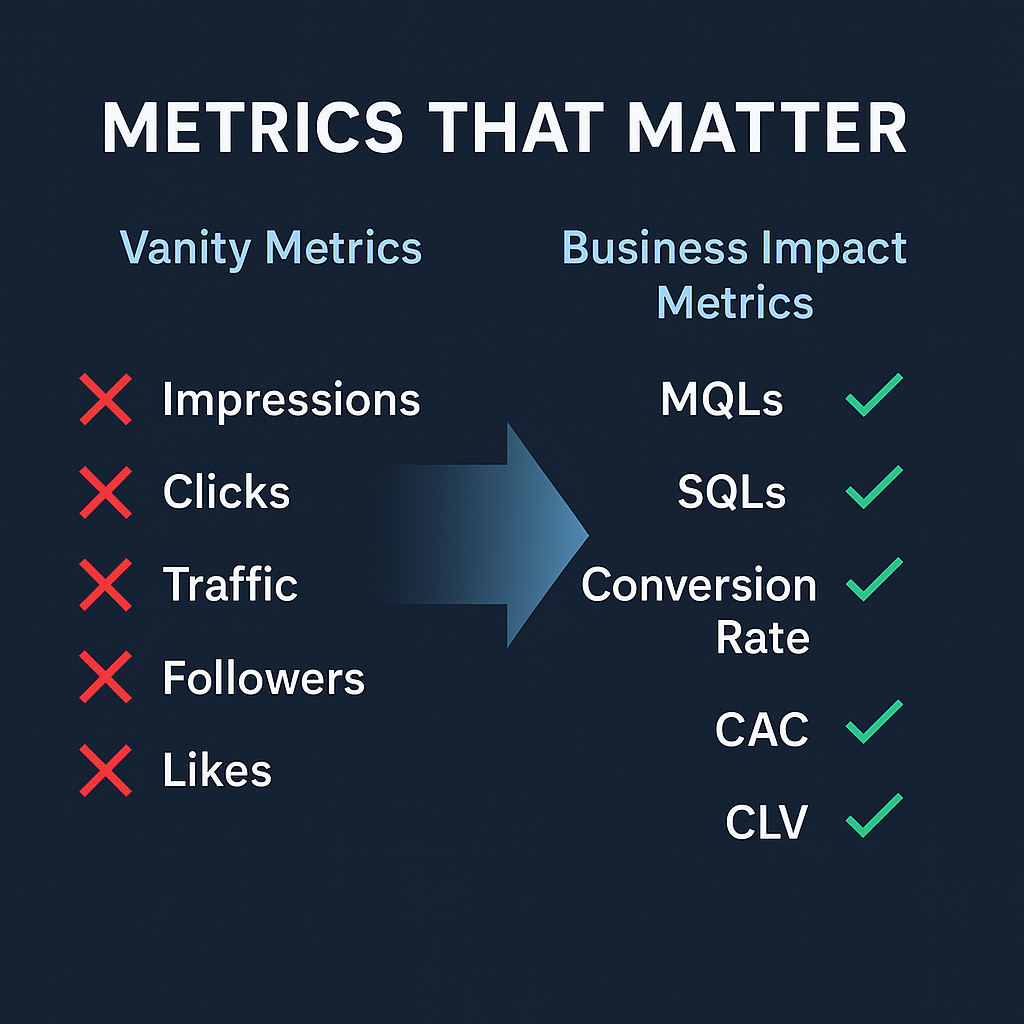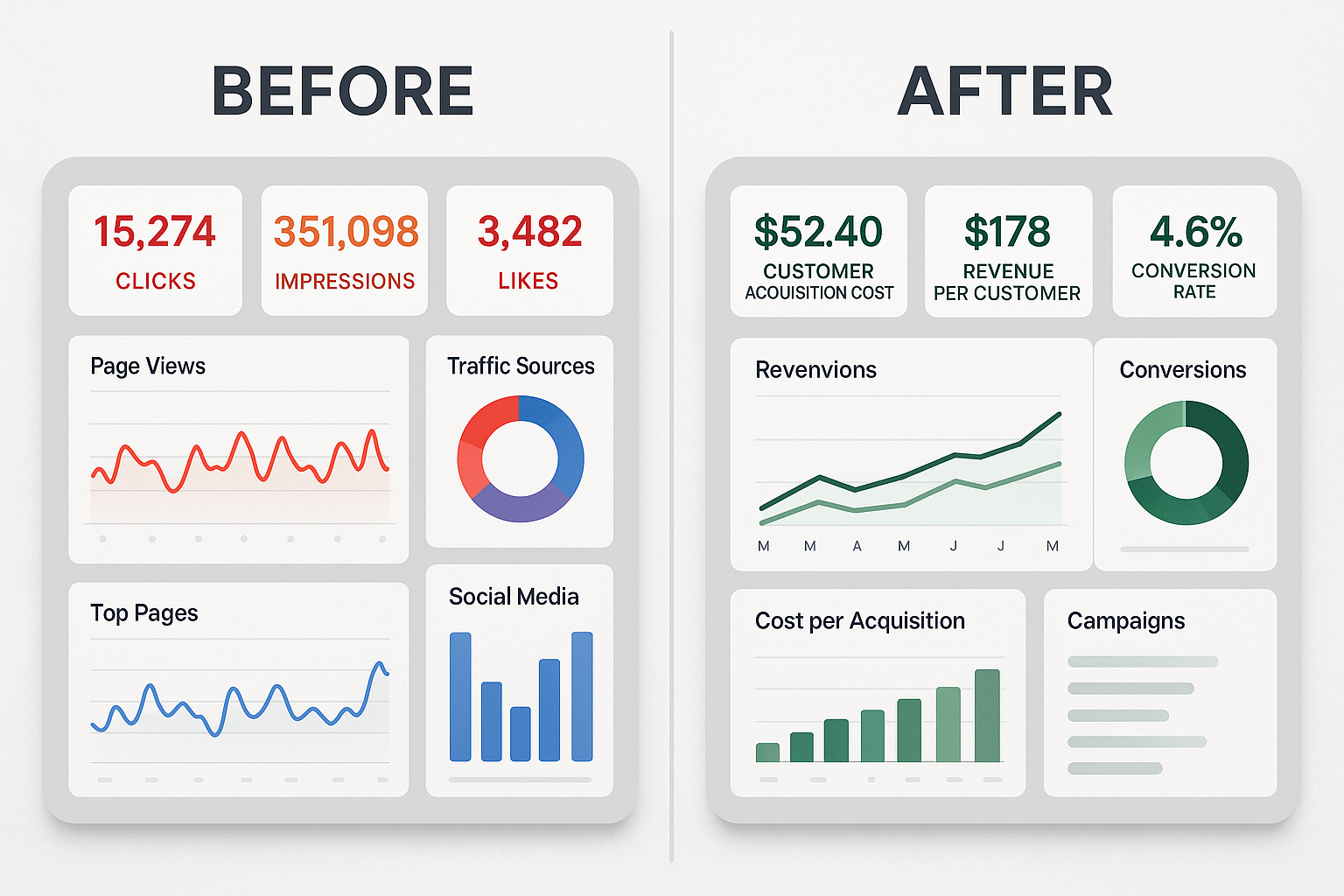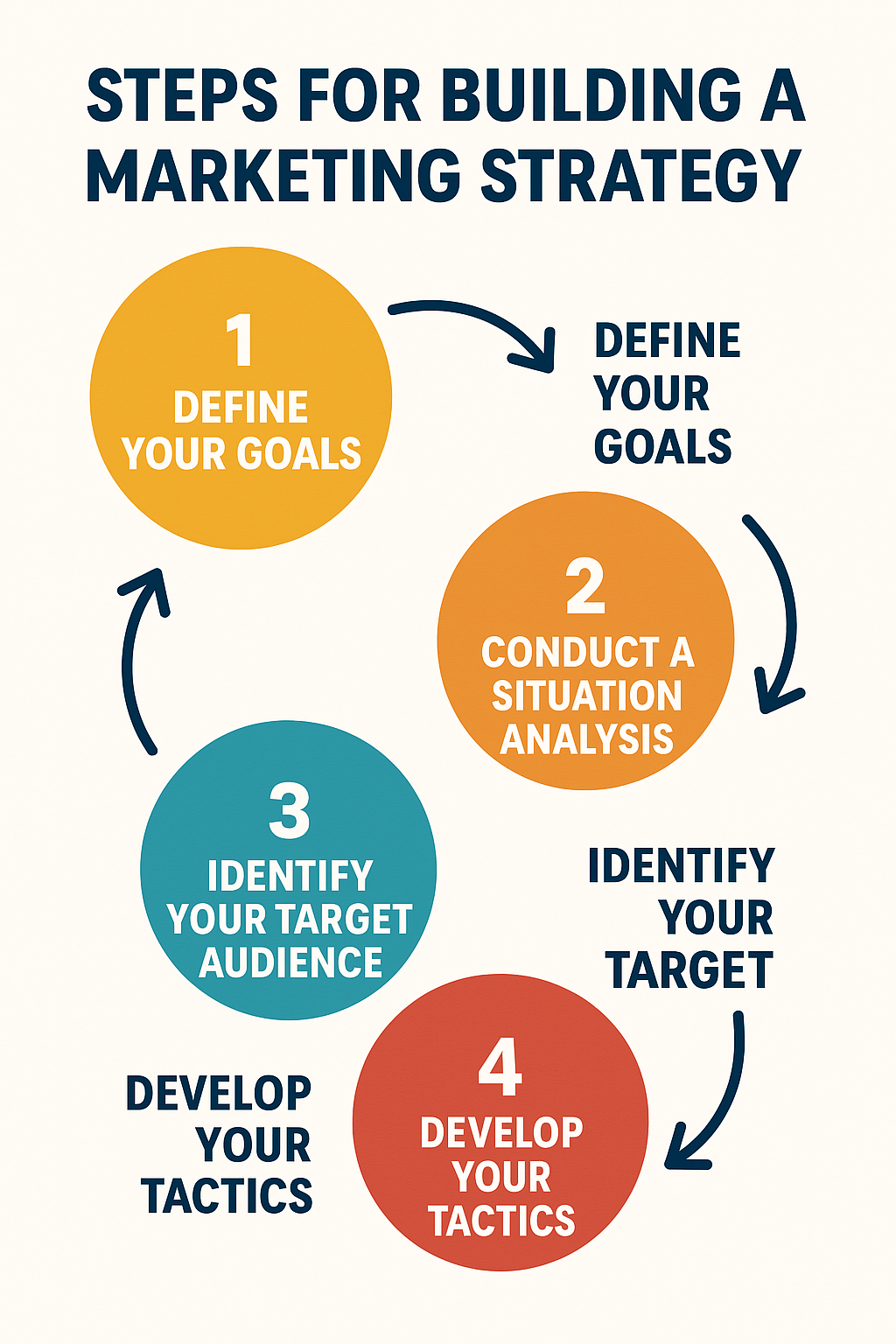Why Your Marketing Strategy Is Just Wishful Thinking (And How Smart Businesses Create Revenue-Driving Plans)
Why Your Marketing Strategy Is Just Wishful Thinking (And How Smart Businesses Create Revenue-Driving Plans)
Strategic Analysis by: Insight2Strategy
Published: September 29, 2025
Executive Reading Time: 8 minutes
Executive Strategic Insights
- Revenue Impact: 77% of marketing teams using systematic frameworks meet revenue goals vs 23% using traditional approaches
- Cost of Inaction: Poor marketing data quality wastes $611 billion annually worldwide
- Strategic Framework: Four-step process transforms marketing from expense to predictable revenue engine
- Implementation Focus: Systematic approach replaces wishful thinking with measurable business outcomes
- Competitive Advantage: Advanced teams outperform traditional marketing approaches by connecting spend to revenue
- Actionable Framework: Complete implementation methodology detailed below
Let me guess: you've been throwing marketing tactics at the wall hoping something sticks. A little LinkedIn here, some Google Ads there, maybe a trade show for good measure. You call it a "strategy," but deep down, you know it's really just educated guessing wrapped in a business plan.
You're not alone in this frustration. According to recent Forrester research on frontline marketing effectiveness, only 77% of marketing teams with beginner or intermediate strategies actually meet their revenue goals—meaning nearly a quarter are falling short of basic performance expectations. Even more concerning, poor marketing data quality alone costs businesses $611 billion annually worldwide, money that could be driving real growth instead of disappearing into ineffective campaigns.

Following along? Get our Marketing Strategy Blueprint Assessment to implement these strategies step-by-step.
Get the Strategic Assessment Guide →The stakes have never been higher. Recent data shows that businesses with poorly aligned marketing efforts face significant survival challenges in today's competitive landscape. If your marketing feels like wishful thinking disguised as strategy, this article will change that. We're going to break down why most marketing plans fail and walk you through the proven 4-step marketing strategy framework that connects every dollar spent to dollars earned.
Why This Matters Now for Strategic Business Leaders
The economic landscape has fundamentally shifted. Marketing budgets are under microscopic scrutiny from boards, investors, and CFOs who aren't interested in vanity metrics like social media followers or website traffic. They want one thing: measurable revenue impact that justifies every marketing dollar invested.
For growing companies, this isn't just about efficiency—it's about survival. With customer acquisition costs rising across industries and competition fiercer than ever, you can't afford to treat marketing as a series of disconnected experiments. You need a revenue-driven marketing strategy that works as a predictable engine, not a lottery ticket.
⚡ Quick Implementation Tip
Start by asking yourself: "If my CFO demanded proof that our marketing generated revenue last quarter, could I provide specific dollar amounts tied to each campaign?" If not, you're operating on hope rather than strategy.
The businesses thriving in this environment aren't necessarily spending more on marketing—they're being dramatically smarter about it. According to Forrester's latest research, 87% of advanced marketing teams that implement systematic lifecycle revenue marketing strategies meet or exceed their revenue plans, compared to only 77% using traditional approaches. They've moved from wishful thinking to systematic frameworks that tie every marketing decision to measurable business outcomes.
The Hard Truth: What Makes Your Current Marketing Strategy Fail
Before we dive into solutions, let's address the elephant in the room. What you probably call your "marketing strategy" isn't actually a strategy at all—it's a collection of tactics with no connecting thread to business results.
A real marketing strategy framework answers three critical questions that most businesses can't answer clearly:
- Who exactly are we serving, and what do they desperately need?
- How do we uniquely solve their problem better than anyone else?
- Which specific actions will predictably drive revenue growth?
If you can't answer these questions with confidence and data to back up your responses, you're operating on wishful thinking. And the cost is measurable: businesses implementing misaligned marketing approaches typically lose 15-20% of potential revenue to inefficiencies, poor data quality, and scattered efforts that don't compound into meaningful results.
Step 1: How Do You Audit Your Current Marketing Reality?
The foundation of any revenue-driven marketing plan starts with brutal honesty about what's actually working versus what you think is working. Most businesses skip this critical step because it's not sexy, but it's the difference between building on solid ground or quicksand.
Your comprehensive marketing audit strategy should examine four critical areas:
Channel Performance Analysis: Which marketing channels are generating qualified leads that actually convert to customers, not just traffic or initial inquiries? Many businesses discover that their "best performing" channels are actually their most expensive when you factor in the full cost of customer acquisition.
True Customer Acquisition Costs: Calculate the real CAC across each channel, including hidden costs like sales time, follow-up sequences, and opportunity costs. Often, the channels that appear cheapest upfront have the highest total cost of acquisition.
Funnel Leak Detection: Identify exactly where prospects are falling out of your conversion process. Most businesses lose 60-80% of potential customers between initial interest and final purchase due to preventable friction points.
Revenue Attribution: Connect your marketing activities to actual closed revenue, not just leads generated. This is where most marketing teams struggle—they can tell you about activities but not outcomes.

For intermediate-level teams, this audit step requires careful cross-department coordination. You'll need clean data from sales, marketing, and customer success to get the complete picture. Our Marketing Strategy Blueprint Assessment includes a comprehensive audit checklist that prevents you from missing critical revenue leaks while providing frameworks to organize and analyze your findings systematically.
📊 Want the Complete Marketing Audit Framework?
This systematic audit process uncovers revenue leaks most businesses miss. Our comprehensive Marketing Strategy Blueprint Assessment includes templates and step-by-step implementation guides for each audit component.
The goal isn't perfection—it's clarity. You need to know where you truly stand before you can chart where you're going.
Step 2: How Do You Define Marketing Success in Business Terms?
Here's where most B2B marketing strategies derail completely. They set goals like "increase website traffic by 30%" or "grow social media followers by 50%." These aren't business objectives—they're vanity metrics that don't pay salaries, fund growth, or satisfy investors.
A serious B2B marketing strategy must tie directly to financial outcomes that matter to your business's success:
Revenue Targets by Channel: Set specific revenue goals for each marketing channel, not just lead targets. If LinkedIn generates 100 leads per month, how much revenue do those leads actually produce after they move through your sales process?
Customer Lifetime Value Optimization: Focus on marketing activities that attract customers with higher long-term value, not just immediate purchase volume. A customer who spends $10,000 initially but churns after six months is worth less than one who spends $5,000 but stays for three years.
Sales Cycle Acceleration Metrics: Measure how your marketing shortens the time from first contact to closed deal. In B2B, reducing sales cycle length by even 10-15% can dramatically improve your marketing ROI.
Cost Per Acquisition Improvements: Track how your marketing optimization reduces the total cost of acquiring new customers across all channels combined.

Research from Forrester's latest lifecycle revenue marketing study shows that 87% of marketing teams with advanced, revenue-connected strategies consistently meet or exceed their business targets, compared to 77% using traditional activity-based metrics.
⚡ Quick Implementation Tip
Apply the "CFO Test" to every marketing goal: If you had to justify this metric to your CFO in terms of business impact, would it pass? If not, refocus on revenue-connected measurements.
Your marketing goals should pass the CFO test: if you had to justify every marketing dollar spent in terms of revenue generated and business impact created, could you do it with confidence? If not, you're still operating on wishful thinking instead of business strategy.
Step 3: How Do You Choose Your Marketing Battles Strategically?
This is where the rubber meets the road, and where most marketing strategies collapse under the weight of trying to do everything at once. With clear customer insights and revenue-tied goals established, you can now select which marketing approaches deserve your investment—and more importantly, which ones don't.
The key principle here is strategic planning for small business: strategic selection, not tactical accumulation. Most marketing strategies fail because they spread resources too thin across too many channels, becoming the marketing equivalent of being a mile wide and an inch deep.
For B2B companies especially, precision matters exponentially more than volume. Your buying cycles are longer, your deal values are higher, and your target audiences are more specific and discerning. This fundamental reality means that focused, high-quality engagement with the right prospects beats broad, shallow engagement with large audiences every single time.
Consider these strategic channel selection criteria:
Audience Alignment: Does this channel actually reach your ideal buyers when they're in active buying mode, or does it just reach people who might someday become customers?
Revenue Potential: Can this channel drive meaningful business outcomes within your sales cycle timeframe, or is it purely a long-term brand-building play?
Resource Reality: Can you execute this channel at a high enough quality level to compete effectively with current resources, or would you need major investment to do it well?
Competitive Advantage: Do you have a unique strength or insight that gives you an edge in this channel, or are you just copying what competitors are doing?

Our Marketing Strategy Blueprint Assessment includes a channel evaluation matrix that helps you prioritize ruthlessly based on these criteria, ensuring you focus your limited resources on the highest-impact opportunities rather than getting distracted by every new marketing trend that emerges.
Step 4: How Do You Build Your Marketing Measurement Engine?
A marketing strategy framework without rigorous measurement is just sophisticated guessing. This final step separates businesses that achieve predictable growth from those that plateau and struggle to scale their marketing impact.
Your measurement system needs to track two distinct types of metrics that work together to give you complete visibility:
Leading Indicators: Activities and early-stage behaviors that predict future revenue, such as content engagement depth, email sequence progression, and sales conversation quality scores.
Lagging Indicators: Actual business outcomes including closed revenue, customer lifetime value, and profitability by customer acquisition source.
Recent research shows that companies adopting closed-loop marketing measurement—where they can trace marketing activities directly to revenue outcomes—improve their marketing ROI by 15-30% in their first year of implementation. More importantly, they gain the ability to see exactly which marketing efforts drive pipeline growth, which deals actually close, and where to double down their future investments.

For intermediate marketing teams, this often requires integrating systems that weren't originally designed to work together seamlessly—your CRM, marketing automation platform, and analytics tools need to communicate in a unified language. The good news is that modern marketing technology makes this integration more accessible than ever, and the ROI from proper measurement typically justifies the initial setup investment within the first quarter.
The key is building measurement that enables optimization, not just reporting. Every metric you track should connect to a decision you can make to improve performance.
Implementation Focus: Your Strategic Monday Morning Action Plan
Here's the reality about medium-complexity strategic planning for small business: they require coordination, discipline, and sustained execution over time. You can't transform your entire approach overnight, but you can start building momentum immediately with focused action.
Week 1: Complete your comprehensive audit using the framework outlined in Step 1. Focus on getting clean data about what's actually working rather than trying to fix everything at once.
Week 2: Set revenue-tied goals and secure sales team alignment on definitions and measurement criteria. This cross-functional alignment is critical for long-term success.
Week 3: Select your priority channels using the evaluation criteria from Step 3, and establish measurement baselines for your optimization engine.
Week 4: Launch your first optimized campaign with proper tracking and clear success criteria established upfront.

The businesses that succeed with this systematic approach aren't necessarily the ones with the biggest marketing budgets—they're the ones that execute consistently and measure ruthlessly. They treat marketing as a strategic business function with predictable inputs and outputs, not as a creative art project with unpredictable results.
If you want to accelerate this implementation process, our Marketing Strategy Blueprint Assessment provides detailed worksheets, audit checklists, and measurement frameworks for each step. It takes the guesswork out of building a revenue-driven approach by giving you proven templates that have worked for hundreds of growing businesses.
Strategic Conclusion: From Wishful Thinking to Revenue Reality
The fundamental difference between wishful thinking and a revenue-driven marketing strategy comes down to systematic execution backed by data and measurement. Smart businesses have moved beyond hoping their marketing works—they've built predictable systems that make marketing work consistently.
This transformation isn't about achieving perfection on day one. It's about replacing random acts of marketing with a connected framework that treats every decision as an investment with expected returns and measurable outcomes. When you can trace a clear line from marketing spend to revenue generated, you're no longer guessing about what works—you're systematically growing your business.
The choice facing every business leader is straightforward: continue throwing money at disconnected tactics and hoping for the best, or invest the time to build a marketing engine that delivers predictable results. With poor marketing decisions costing businesses hundreds of billions annually worldwide, and advanced marketing teams consistently outperforming traditional approaches, the time for wishful thinking has passed.
Ready to Transform Your Marketing Strategy from Guesswork to Growth?
Get our comprehensive Marketing Strategy Blueprint Assessment with templates and frameworks used by 500+ growing businesses to connect marketing spend to measurable revenue.
No fluff. Just actionable strategies you can implement immediately.
Frequently Asked Questions
How long does implementing a systematic marketing strategy framework typically take?
Most businesses see initial results within 4-6 weeks following our implementation timeline. The audit phase takes 1-2 weeks, goal setting and team alignment require 1 week, channel selection and baseline establishment need 1 week, and the first optimized campaign launch happens in week 4. However, building a fully mature measurement system that connects all marketing activities to revenue typically takes 2-3 months of consistent execution.
What budget should we allocate for transitioning from traditional to systematic marketing?
The transition itself doesn't require additional marketing spend—it's about reallocating existing budget more strategically. However, you should budget for potential technology integration costs (CRM, marketing automation, analytics tools) which typically range from $200-2000/month depending on business size. The ROI improvement of 15-30% typically justifies these costs within the first quarter.
When should we hire outside marketing strategy expertise versus handling this internally?
Consider outside expertise if: your internal team lacks systematic marketing experience, you're missing revenue targets by more than 15%, or your marketing-to-sales handoff is broken. Handle internally if: you have analytical team members, strong sales-marketing alignment, and time to implement gradual changes. The framework works either way, but expertise accelerates results.
How do we measure ROI on implementing a systematic marketing approach?
Track three key indicators: 1) Revenue attribution clarity (can you connect marketing spend to closed deals?), 2) Customer acquisition cost trends (should decrease 10-25% within 6 months), and 3) Marketing qualified lead to customer conversion rates (should improve 15-30%). The clearest ROI indicator is your ability to predict revenue based on marketing investment levels.
About Insight2Strategy
We help growing businesses transform their marketing from guesswork into predictable revenue engines. Our systematic approach has helped 500+ companies connect marketing spend to measurable business outcomes.
Strategic Marketing | Revenue Growth | Business Consulting



Comments
Post a Comment